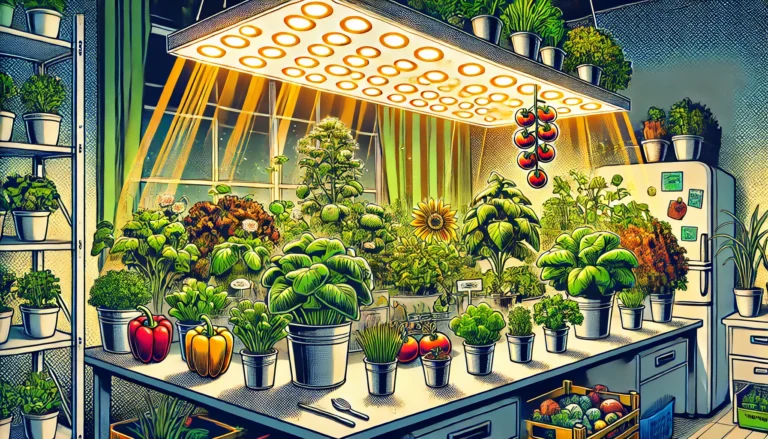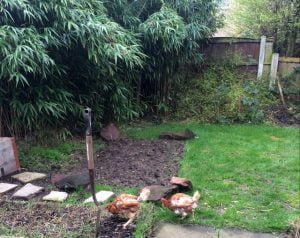Table of contents
- Introduction
- Best LED Grow Lights for Leafy Greens
- Comparison Table: Mars Hydro TS 1000 vs Other LED Grow Lights
- Best LED Grow Lights for Fruiting Plants (Tomatoes, Peppers)
- Comparison Table: Phlizon CREE COB LED vs HPS Grow Lights
- Best LED Grow Lights for Root Vegetables
- Comparison Table: Roleadro LED Grow Light vs KingLED 1000W
- Section 4: Comparing LED Grow Lights for Different Plant Types
- Comparison Table: LED Grow Lights for Different Plant Types
- Why Comparing Grow Lights is Important
- Conclusion: Choosing the Best LED Grow Light for Your Indoor Plants
Introduction
Indoor gardening is thriving, and LED grow lights have become essential for anyone growing plants indoors. These lights are energy-efficient and provide the full spectrum of light plants need to thrive. However, not all plants require the same type of lighting, so choosing the right LED grow light is crucial for success.
In this article, we’ll help you select the best LED grow lights for different types of plants—whether you’re growing leafy greens, fruiting plants, or root vegetables.
To see how these light recommendations line up with top overall models, have a look at our guide to the best LED grow lights for indoor gardens.
Why Choose LED Grow Lights for Indoor Plants?
LED grow lights are popular because they:
- Use less energy and last longer than traditional lighting options.
- Emit less heat, which protects your plants from damage.
- Provide full-spectrum lighting, mimicking natural sunlight for healthier growth.
1. Energy Efficiency
LED grow lights consume less energy while delivering better results. Traditional grow lights like HPS or fluorescent bulbs waste energy by emitting excess heat. In contrast, energy-efficient LED grow lights convert more energy into light, saving costs and improving sustainability.
- Why it matters: Lower energy consumption reduces electricity bills and makes indoor gardening more eco-friendly.
2. Full-Spectrum Lighting
Plants require different spectrums of light at various stages of their growth. For instance:
- Leafy greens need more blue light for vegetative growth.
- Fruiting plants need more red light to stimulate flowering and fruiting.
Full-spectrum LED grow lights provide a balanced range of light, closely replicating natural sunlight.
- Why it matters: Full-spectrum lighting ensures plants get the exact type of light they need for each growth stage.
If you’re new to LED growing, start with the basics anout LED lights here.
3. Matching Grow Lights to Plant Types
Each plant type has specific lighting needs:
- Leafy greens (like spinach and lettuce) thrive with light focused on vegetative growth.
- Fruiting plants (such as tomatoes and peppers) need more intense light for flowers and fruit.
- Root vegetables (like carrots and radishes) require a balanced mix of red and blue light for overall growth.
- Why it matters: Choosing the correct LED grow light for your plant type ensures better growth and higher yields.
Best LED Grow Lights for Leafy Greens
Why Leafy Greens Need Specific Lighting
Leafy greens like spinach, lettuce, kale, and herbs thrive when they receive light that enhances vegetative growth. These plants require a higher concentration of blue spectrum light, which promotes the development of lush, healthy leaves.
- Key Light Requirement: Blue spectrum light encourages strong, leafy growth in plants that are primarily foliage-based.
- Why it matters: The right light spectrum boosts photosynthesis, helping leafy greens grow faster and healthier.
Recommended Grow Light: Mars Hydro TS 1000
The Mars Hydro TS 1000 is an excellent choice for leafy greens, thanks to its full-spectrum LED coverage that emphasizes the blue spectrum. It’s compact yet powerful, making it perfect for small indoor setups or hydroponic systems.
- Features:
- Full-spectrum lighting with a focus on blue light for vegetative growth.
- Energy-efficient, using less power while providing strong light output.
- Low heat emission, which prevents delicate greens from overheating.
- Why it matters: The Mars Hydro TS 1000 delivers the perfect balance of blue and red light, encouraging lush, leafy growth while minimizing energy usage.
- [Insert affiliate link to Mars Hydro TS 1000]
Performance for Leafy Greens
The Mars Hydro TS 1000 offers excellent performance for leafy greens by providing the ideal light conditions for growth. This grow light is especially effective for plants that rely on strong vegetative development.
- Ideal Plants:
- Lettuce
- Spinach
- Kale
- Herbs like basil, parsley, and cilantro
- Why it matters: Leafy greens require consistent, high-quality blue light to develop healthy leaves. The Mars Hydro TS 1000 excels at delivering this, promoting faster growth and stronger plants.
For a complete guide on growing greens indoors, check out our How to Grow Salad Greens and Herbs Indoors article.
Advantages of Using Mars Hydro TS 1000
The Mars Hydro TS 1000 stands out for its combination of energy efficiency, light intensity, and compact design, making it a top choice for small indoor setups and hydroponic gardens.
- Energy Efficiency:
- Consumes less energy while providing high-intensity light, making it cost-effective for home growers.
- Full-Spectrum Lighting:
- Includes both blue and red light, although it leans towards blue, which is perfect for leafy greens.
- Low Heat Output:
- Ensures your plants won’t suffer from heat stress, even when grown in confined indoor spaces.
Best LED Grow Light for Leafy Greens: Mars Hydro TS 1000 vs Competitors
Here’s a quick comparison of the Mars Hydro TS 1000 with other popular grow lights for leafy greens:
Comparison Table: Mars Hydro TS 1000 vs Other LED Grow Lights
| Feature | Mars Hydro TS 1000 | Standard LED Grow Light | Fluorescent Grow Light |
| Light Spectrum | Full-spectrum with blue emphasis | Basic full-spectrum | Mainly blue and white |
| PAR Value | High, ideal for vegetative growth | Moderate, less suited for leafy greens | Low, inconsistent light intensity |
| Energy Efficiency | High, consumes less power | Moderate, consumes more energy | Low, requires frequent replacements |
| Heat Emission | Low, suitable for small spaces | Moderate, can cause heat issues | Low, but less effective light output |
| Lifespan | Long-lasting (50,000+ hours) | Shorter lifespan (20,000-30,000 hours) | Shorter (10,000-20,000 hours) |
| Cost Over Time | More cost-effective due to efficiency | Higher due to electricity use | Higher due to frequent replacements |
- Why it matters: The Mars Hydro TS 1000 outperforms other LED and fluorescent grow lights in terms of energy efficiency, light spectrum, and heat emission, making it the best choice for leafy greens.
Best LED Grow Lights for Fruiting Plants (Tomatoes, Peppers)
Why Fruiting Plants Need High-Intensity Lighting
Fruiting plants, such as tomatoes, peppers, and strawberries, need more intense light to produce flowers and fruit. While leafy greens focus on vegetative growth, fruiting plants require red-spectrum light to support flowering and maximize fruit yield.
- Key Light Requirement: Red light plays a crucial role in stimulating flowering and fruit production.
- Why it matters: The right light spectrum helps fruiting plants transition from vegetative growth to flowering, resulting in a higher yield.
Recommended Grow Light: Phlizon CREE COB Series
The Phlizon CREE COB Series is perfect for fruiting plants due to its high-intensity light and full-spectrum coverage, which includes red, blue, UV, and IR. This powerful LED grow light delivers deep light penetration, which is essential for supporting fruiting plants during their most critical growth stages.
- Features:
- Full-spectrum lighting with emphasis on the red spectrum for flowering.
- High PAR value, providing intense light for large fruiting plants.
- Energy-efficient, saving costs while delivering powerful light.
- Why it matters: This grow light supports all stages of growth, from seed to harvest, but excels at promoting fruiting and flowering.
- [Insert affiliate link to Phlizon CREE COB Series]
Performance for Fruiting Plants
The Phlizon CREE COB ensures that fruiting plants receive the intense light they need to thrive. Its balanced spectrum promotes healthy growth while maximizing fruit production.
- Ideal Plants:
- Tomatoes
- Peppers
- Strawberries
- Why it matters: Fruiting plants like tomatoes and peppers need the intense, penetrating light that the Phlizon CREE COB provides, resulting in larger, healthier fruits.
Comparison: Phlizon CREE COB LED vs HPS Grow Lights
While HPS (High-Pressure Sodium) grow lights were once the standard for fruiting plants, LED grow lights have surpassed them in terms of energy efficiency and light quality. The table below highlights the key differences:
Comparison Table: Phlizon CREE COB LED vs HPS Grow Lights
| Feature | Phlizon CREE COB LED Grow Light | HPS Grow Light |
| Light Spectrum | Full-spectrum (red, blue, UV, IR) | Primarily red and orange spectrum |
| PAR Value | High, providing deep light penetration | Moderate, less effective for large plants |
| Energy Efficiency | High, consumes less power | Low, consumes more power |
| Heat Emission | Low, reduces plant stress | High, can cause overheating |
| Lifespan | Long-lasting (50,000+ hours) | Shorter lifespan (10,000-24,000 hours) |
| Ideal for | Fruiting plants (tomatoes, peppers) | Fruiting plants but with more heat management |
| Cost Over Time | More cost-effective due to efficiency | Higher due to electricity usage |
| Environmental Impact | Eco-friendly, uses less power | Less eco-friendly, higher energy consumption |
- Why it matters: LEDs outperform HPS lights by providing better light quality without excessive heat, which is crucial for indoor growers looking to optimize fruiting plants.
Best LED Grow Lights for Root Vegetables
Why Root Vegetables Need Balanced Lighting
Root vegetables, such as carrots, radishes, and beets, require a balanced mix of blue and red spectrum light. While the blue spectrum helps with vegetative growth above ground, the red spectrum promotes root development below the soil.
- Key Light Requirement: Balanced lighting supports both foliage and root growth, ensuring a healthy plant overall.
- Why it matters: With the right balance of blue and red light, root vegetables can develop stronger, healthier roots, which are essential for their growth.
Recommended Grow Light: Roleadro LED Grow Light or KingLED 1000W
Both the Roleadro LED Grow Light and KingLED 1000W are excellent choices for growing root vegetables indoors. These lights provide full-spectrum coverage, making them versatile for both vegetative and root development.
- Features:
- Full-spectrum light for both above-ground and below-ground growth.
- Energy-efficient, reducing power usage while providing strong light intensity.
- Deep light penetration for supporting root development.
- Why it matters: Both lights offer the right mix of light spectrums to encourage root vegetables to grow healthy foliage while developing strong roots underground.
- [Insert affiliate links to Roleadro LED Grow Light and KingLED 1000W]
Performance for Root Vegetables
Both the Roleadro LED Grow Light and KingLED 1000W perform well for root vegetables by providing balanced light, ensuring that both the plant’s foliage and roots develop properly.
- Ideal Plants:
- Carrots
- Radishes
- Beets
- Turnips
- Why it matters: Root vegetables require both light above the soil and energy directed towards root growth. These grow lights ensure both parts of the plant are adequately supported.
Advantages of Using Roleadro and KingLED Grow Lights
Both Roleadro LED Grow Light and KingLED 1000W offer full-spectrum lighting with deep penetration, ideal for root vegetable growth. Let’s look at their key benefits:
- Full-Spectrum Lighting:
- Supports both vegetative and root growth, ensuring healthy development above and below the soil.
- Energy Efficiency:
- Both lights are energy-efficient, helping you reduce electricity costs while maintaining excellent light output.
- Deep Light Penetration:
- Provides enough intensity to reach the lower parts of your plants, promoting stronger root systems.
Best LED Grow Light for Root Vegetables: Roleadro vs KingLED 1000W
Here’s a quick comparison of the Roleadro LED Grow Light and KingLED 1000W to help you decide which is best for your root vegetables:
Comparison Table: Roleadro LED Grow Light vs KingLED 1000W
| Feature | Roleadro LED Grow Light | KingLED 1000W |
| Light Spectrum | Full-spectrum (blue and red emphasis) | Full-spectrum (balanced spectrum) |
| PAR Value | High, good for root penetration | Very high, deep penetration for root growth |
| Energy Efficiency | High, consumes less power | Moderate, slightly more power usage |
| Heat Emission | Low, reduces stress on plants | Low, stays cool even in small spaces |
| Lifespan | Long-lasting (50,000+ hours) | Long-lasting (50,000+ hours) |
| Cost Over Time | More cost-effective due to efficiency | Slightly higher due to power usage |
| Ideal for | Root vegetables (carrots, radishes) | Root vegetables (beets, turnips) |
- Why it matters: Both lights are excellent choices for root vegetables, but the KingLED 1000W offers deeper light penetration, making it slightly better for larger setups. The Roleadro is more energy-efficient, making it ideal for smaller indoor gardens.
Section 4: Comparing LED Grow Lights for Different Plant Types
Choosing the right LED grow light for different plant types—leafy greens, fruiting plants, and root vegetables—is essential for ensuring healthy growth and maximizing yields. Each type of plant requires a different light spectrum and intensity to support its specific growth stages.
Leafy Greens (Lettuce, Spinach, Kale)
- Light Spectrum Needed: Leafy greens benefit most from blue spectrum light, which encourages vegetative growth.
- Ideal Light Intensity: Moderate to high intensity with a focus on blue light promotes lush, dense leaf growth.
- Recommended Grow Light: Mars Hydro TS 1000 (Full-spectrum with blue emphasis).
- Why it matters: The right blue light helps leafy greens develop healthy foliage, improving the overall quality of the crop.
Fruiting Plants (Tomatoes, Peppers, Strawberries)
- Light Spectrum Needed: Fruiting plants require a strong emphasis on red spectrum light to stimulate flowering and fruit production.
- Ideal Light Intensity: High intensity with deep penetration is necessary for fruiting plants to bloom and produce fruit.
- Recommended Grow Light: Phlizon CREE COB Series (Full-spectrum with red emphasis).
- Why it matters: Red light is essential for fruiting plants to transition from vegetative growth to flowering, which leads to larger fruit yields.
Root Vegetables (Carrots, Radishes, Beets)
- Light Spectrum Needed: Root vegetables need a balance of blue and red spectrum light to support both foliage and root growth.
- Ideal Light Intensity: Moderate intensity with deep light penetration ensures strong root development underground.
- Recommended Grow Lights: Roleadro LED Grow Light or KingLED 1000W (Full-spectrum with deep penetration).
- Why it matters: Root vegetables need balanced light to support growth above and below ground, ensuring a healthy plant and strong roots.
Comparison Table: LED Grow Lights for Different Plant Types
| Plant Type | Ideal Light Spectrum | Recommended Light Intensity | Best LED Grow Light |
| Leafy Greens | Blue spectrum (full-spectrum with blue) | Moderate to high | Mars Hydro TS 1000 |
| Fruiting Plants | Red spectrum (full-spectrum with red) | High intensity with deep penetration | Phlizon CREE COB Series |
| Root Vegetables | Balanced spectrum (blue and red) | Moderate intensity with deep penetration | Roleadro LED Grow Light or KingLED 1000W |
For further expert advice on the benefits of LED grow lights, you can visit the Royal Horticultural Society’s guide on grow lights.
Choosing the Right LED Grow Light for Your Plants
When selecting an LED grow light for your indoor garden, it’s important to consider the specific needs of each plant type. Leafy greens, for example, require more blue light to support vegetative growth, while fruiting plants need a stronger red light for flowering and fruit production. Root vegetables, on the other hand, benefit from a balanced light spectrum that supports both above-ground foliage and underground root development.
- Why it matters: By matching the right grow light to your plant type, you can optimize growth, improve plant health, and maximize yields.
Benefits of Full-Spectrum LED Grow Lights
Full-spectrum LED grow lights offer a comprehensive range of light that mimics natural sunlight, making them ideal for indoor gardening. They can support plants at every growth stage, from seedling to harvest.
- Energy-Efficient: Full-spectrum LED lights consume less power while providing a high level of light intensity.
- Low Heat Emission: They produce less heat than traditional grow lights, which reduces the risk of heat stress on your plants.
- Long Lifespan: LED grow lights can last for up to 50,000 hours, making them a cost-effective choice for home gardeners.
Why Comparing Grow Lights is Important
Different plant types have unique lighting needs, and choosing the wrong grow light can hinder growth and reduce yields. The comparison table above helps gardeners quickly identify which LED grow light is best suited for their plants, ensuring they get the light they need to thrive.
- Why it matters: Making an informed decision based on your plant type ensures you invest in the best possible grow light for optimal indoor gardening success.
Here’s the Conclusion developed for the article, keeping it concise, clear, and action-oriented:
Conclusion: Choosing the Best LED Grow Light for Your Indoor Plants
Selecting the right LED grow light is essential for ensuring your indoor plants thrive, whether you’re growing leafy greens, fruiting plants, or root vegetables. The specific light needs of each plant type vary, with leafy greens requiring more blue light, fruiting plants needing strong red light, and root vegetables benefiting from a balanced light spectrum.
By using the appropriate grow light, you’ll:
- Optimize growth: Matching the correct light spectrum to your plants ensures faster, healthier development.
- Improve plant health: The right intensity and spectrum reduce stress on plants, promoting stronger roots, leaves, flowers, and fruits.
- Maximize yields: Providing plants with the light they need at each stage of growth results in higher yields and better-quality produce.
Recommended LED Grow Lights for Different Plants:
- Leafy Greens: Use the Mars Hydro TS 1000 for its full-spectrum light with an emphasis on the blue spectrum, ideal for promoting lush, green foliage.
- Fruiting Plants: Choose the Phlizon CREE COB Series, which delivers high-intensity red light, essential for flowering and fruit production.
- Root Vegetables: Opt for the Roleadro LED Grow Light or KingLED 1000W, both of which provide balanced light, promoting both vegetative growth and root development.
Final Tips:
- Ensure your grow light provides full-spectrum coverage for versatility, supporting all growth stages.
- Consider the energy efficiency of the light to save on power costs, especially for long-term use.
- Evaluate the light’s intensity and heat emission to prevent plant stress, particularly in confined indoor spaces.
By carefully choosing the right LED grow light based on your plant type and growing conditions, you’ll be able to create a thriving indoor garden that maximizes your plants’ potential. Use the recommendations and comparison tables in this article to help you make the best choice for your needs.Explore the best LED grow lights through the affiliate links provided to start growing your ideal indoor garden today!





